Defending Your Home’s Electrical Nervous System
A home surge protection system is a specialized safeguard that protects your entire electrical system from voltage spikes by diverting excess electricity safely to the ground before it can damage your electronics and appliances.
Quick Guide to Home Surge Protection Systems:
- What it is: A device installed at your electrical panel that diverts harmful voltage spikes
- How it works: Uses metal oxide varistors (MOVs) to redirect excess voltage to ground
- Types: Whole-house (panel-mounted) and point-of-use (plug-in) protectors
- Protection level: Whole-house systems protect all circuits; rated by kA capacity (25kA-80kA)
- Installation: Requires a licensed electrician for safe, code-compliant installation
- Cost benefit: Protects thousands of dollars in home electronics and appliances
Today’s modern homes contain an estimated $15,000 worth of electronics and may experience up to 100 surges per month that can damage or degrade your devices. While many homeowners think of dramatic lightning strikes when considering surge protection, the truth is that 60-80% of power surges actually originate from inside your home—from appliances cycling on and off, faulty wiring, or utility grid switching.
The National Electrical Code (NEC) now recognizes this risk, with the 2020 update requiring surge protection in many states for service replacements and upgrades. This shift highlights what industry professionals have long known: comprehensive surge protection isn’t optional in our increasingly connected homes—it’s essential.
Unlike basic power strips that offer limited protection and often fail after a single event, whole-house surge protectors install directly at your electrical panel to provide frontline defense for every circuit in your home. They’re designed to withstand multiple surges over many years, protecting everything from your refrigerator and HVAC system to your smart TV and computer equipment.
I’m Clay Hamilton, President of Grounded Solutions, bringing over two decades of hands-on expertise in electrical systems including the installation and maintenance of home surge protection systems throughout Indianapolis and central Indiana.
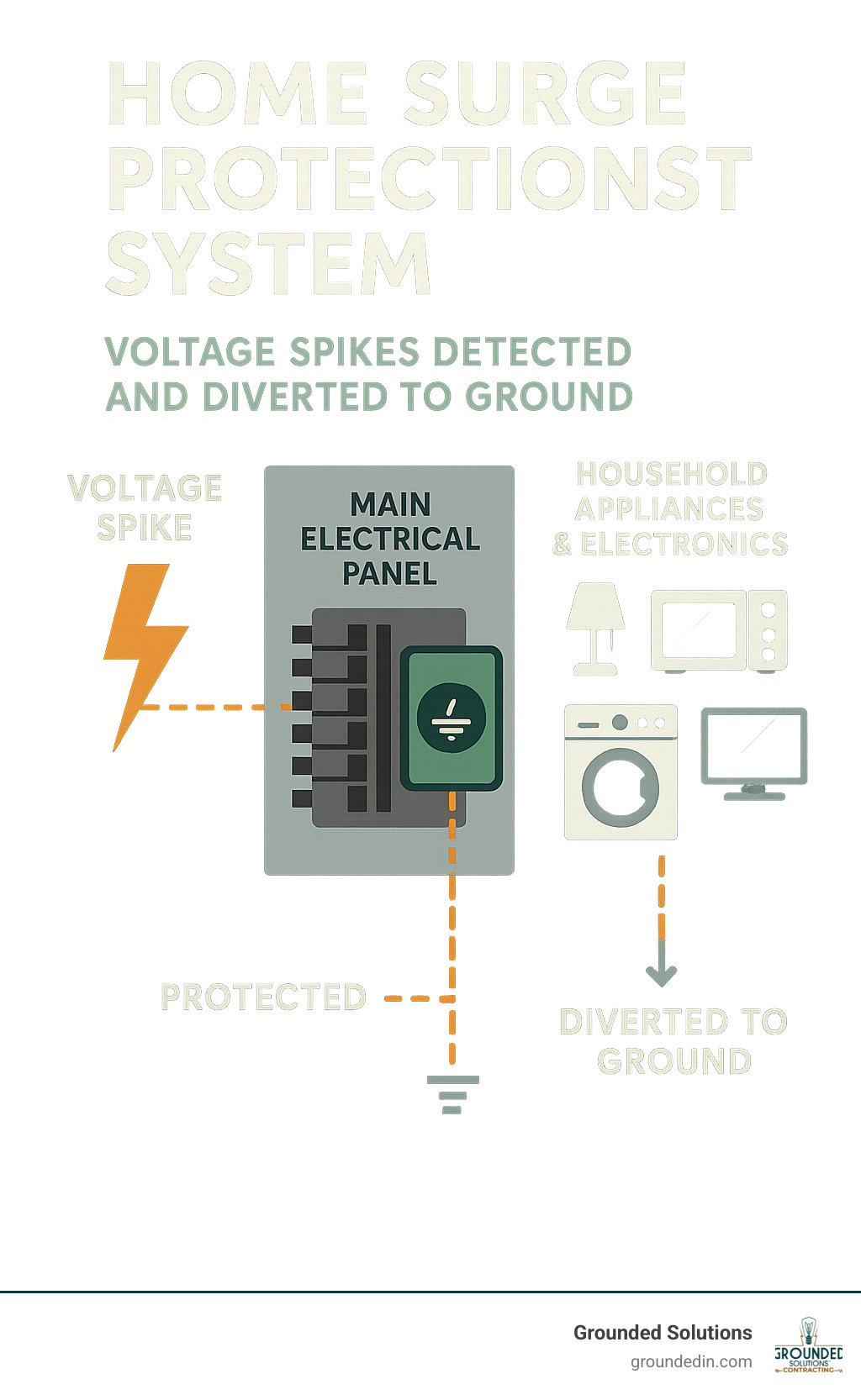
Why Power Surges Matter
In central Indiana, our homes face a constant barrage of electrical challenges. From summer thunderstorms rolling across Carmel and Fishers to the daily cycling of HVAC systems in Greenwood and Plainfield, the threat of power surges is ever-present.
I’ve seen countless homes affected by these invisible threats during my years at Grounded Solutions. Many homeowners are surprised when I tell them their homes typically experience up to 100 surges every month. It’s like watching your electronics suffer death by a thousand cuts – small damages that add up over time.
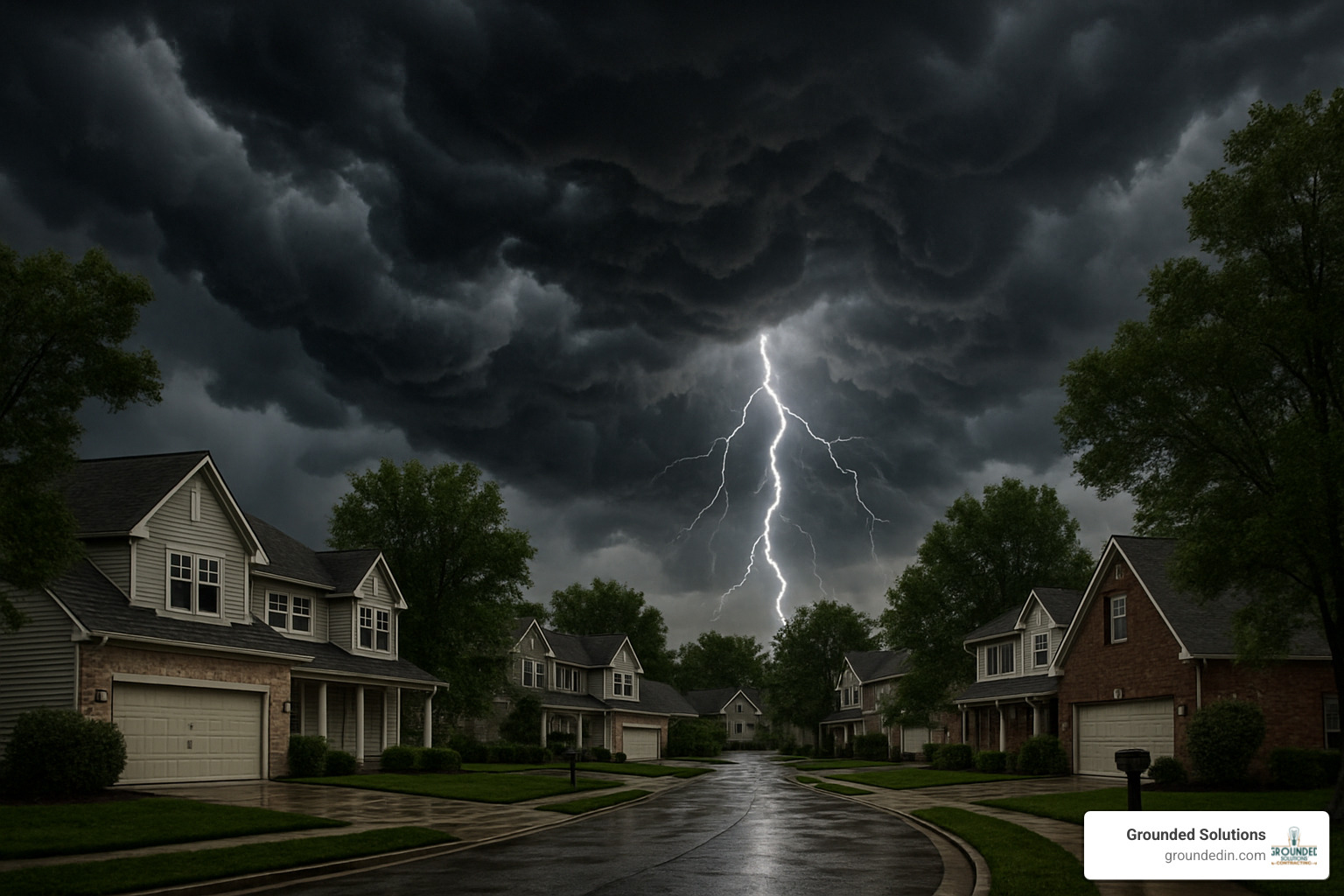
What makes this particularly concerning? The average modern Indianapolis home contains over $20,000 worth of electronics. From your smart refrigerator and programmable thermostat to your home theater system and work-from-home setup, each device contains sensitive microprocessors vulnerable to even minor voltage fluctuations. And here’s the surprising part – while most people worry about lightning strikes, about 80% of power surges actually originate from inside your own home.
Electrical Surge Anatomy: Micro to Mega
Not all power surges are created equal. They range from barely noticeable micro-surges to catastrophic spikes that can instantly fry your electronics:
Micro-surges (under 100 volts) happen when appliances like refrigerators, air conditioners, and hair dryers cycle on and off. While each one seems insignificant, they gradually wear down your electronics over time – like waves slowly eroding a shoreline.
Medium surges (100-500 volts) typically result from utility grid switching or minor electrical issues. These can immediately damage sensitive electronics and slowly degrade larger appliances. Your smart TV might fail immediately, while your refrigerator’s control board suffers invisible damage.
Major surges (500+ volts) usually come from lightning strikes or major utility problems. Without protection, these can instantly destroy unprotected devices throughout your home, leaving you with a hefty replacement bill.
The science behind surges involves transient voltage—brief, unexpected increases in electrical pressure. When your home’s standard 120-volt system experiences a surge, that excess energy needs somewhere to go. Without proper protection, it travels through your wiring and into connected devices, causing either immediate failure or long-term degradation.
Home wiring can also generate surges through load switching (when large appliances turn on or off) and capacitor kickback (when motors stop running). These events create brief but potentially harmful voltage spikes that travel throughout your home’s electrical system.
Damage Scorecard: Appliances vs Electronics
Not all electrical devices face the same risk from surges. Your most vulnerable items include smart home devices, computers, gaming systems, and TVs with their delicate motherboards and processors. Moderately vulnerable equipment includes modern refrigerators, washers and dryers with digital interfaces, and HVAC system control boards. Even supposedly “less vulnerable” items like basic appliances with mechanical controls aren’t completely safe.
What makes modern devices particularly susceptible is their reliance on microprocessors and circuit boards. Even a modest 600-volt spike can permanently damage these components. And these sensitive electronics aren’t just in your laptop—they’re in your refrigerator, your thermostat, even your garage door opener.
Beyond immediate failure, surges cause gradual degradation of electronic components, unexplained device resets, data loss on computers and smart devices, shortened appliance lifespans, and even increased energy consumption due to damaged components.
I’ve seen clients puzzled by refrigerators that suddenly stop cooling, TVs with mysterious dead pixels, and Wi-Fi networks that inexplicably drop. Often, these issues trace back to electrical surges that weakened components over time. Without proper protection, your valuable electronics remain at constant risk – particularly in our Indiana climate where summer storms bring additional surge threats.
A home surge protection system isn’t just about protecting your investments; it’s about maintaining the reliability and longevity of the devices your family depends on every day.
Home Surge Protection System Fundamentals
Think of your home’s electrical system as a living, breathing network—one that needs protection from the harsh realities of power fluctuations. A home surge protection system creates multiple shields between incoming electricity and your valuable devices, working silently in the background to keep everything safe.
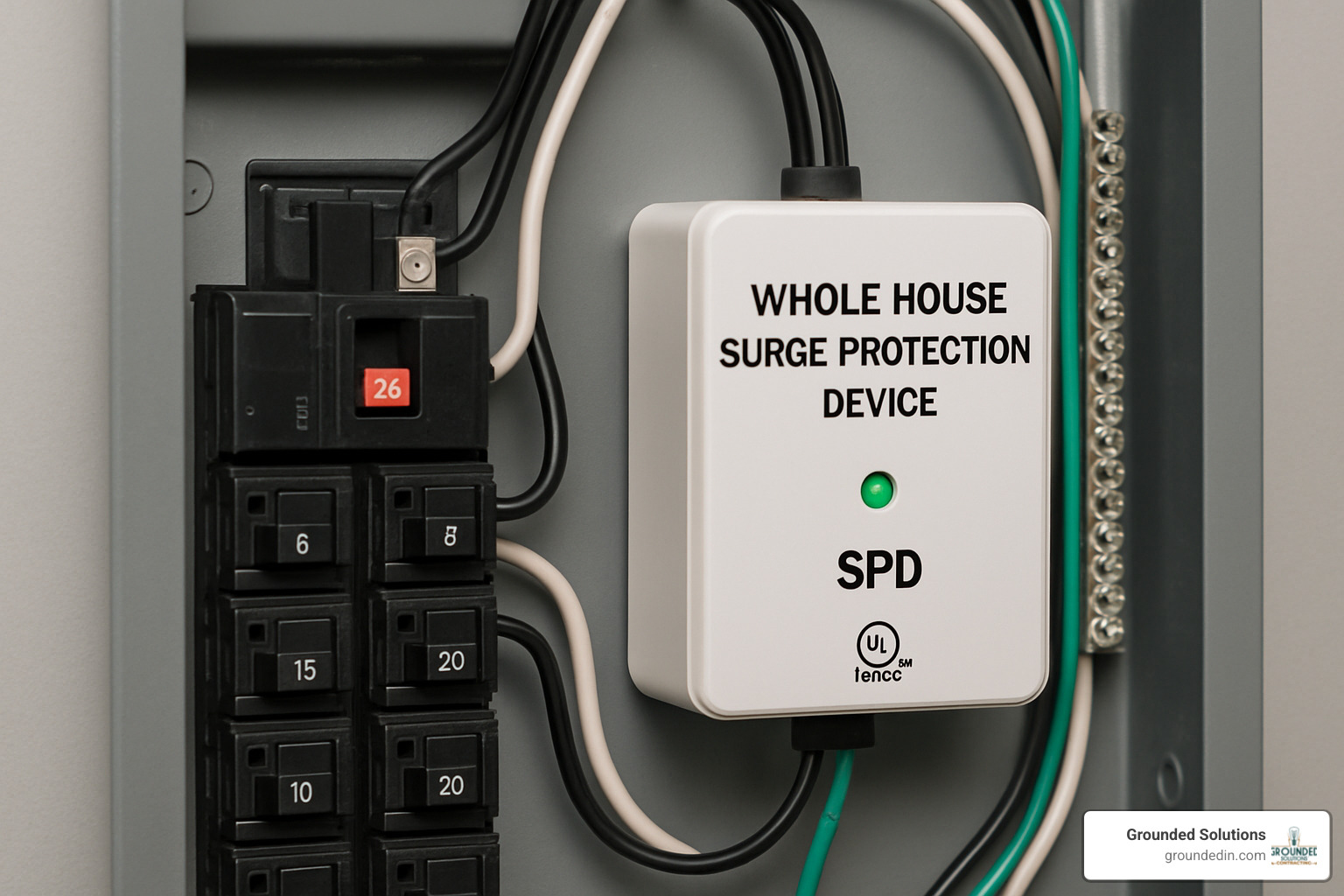
What Is a Home Surge Protection System?
When we talk about a home surge protection system, we’re describing more than just a power strip you plug into the wall. We’re talking about a network of surge protective devices strategically placed throughout your home, with the main defender mounted right at your electrical panel.
These systems operate on a beautifully simple principle that’s been refined over decades: they detect voltage spikes and instantly create an alternative path for that excess electricity to travel safely to ground. Inside each protector are components called metal oxide varistors (MOVs) or silicon avalanche diodes (SADs)—I like to call them the “unsung heroes” of your electrical system.
“Think of a home surge protection system as a traffic controller for electricity,” as one of our lead technicians at Grounded Solutions often tells homeowners. “It keeps the good electricity flowing to your devices while directing the dangerous excess away from them.”
When normal voltage flows through your home, these components allow electricity to pass without interference. But the moment a surge occurs—whether from lightning or your air conditioner cycling on—they spring into action, diverting that potentially damaging electricity away from your valuable electronics.
| Feature | Whole-House Protectors | Plug-in Protectors |
|---|---|---|
| Installation location | Main electrical panel | Individual outlets |
| Protection coverage | All connected circuits | Only plugged-in devices |
| Surge capacity | 25,000-80,000 amps | Typically under 6,000 amps |
| Lifespan | 5-10 years | Often 1-3 years |
| Protects hardwired appliances | Yes | No |
| Requires professional installation | Yes | No |
| Provides status indicator | Yes (most models) | Some models |
| Warranty coverage | Often includes connected equipment | Limited or none |
Main Types of Surge Protection Devices
Not all surge protectors are created equal. Depending on where they’re installed and what they’re designed to handle, they fall into three distinct categories:
Type 1 SPDs are the heavyweight champions of surge protection. Installed right where power enters your home, these robust devices stand ready to absorb direct lightning strikes and major external surges. They form your first line of defense and require professional installation by licensed electricians (like our team at Grounded Solutions). Think of them as the bouncers at the front door of your electrical system.
Type 2 SPDs are what most people picture when they think of whole-house surge protection. Mounted at your main electrical panel, these versatile protectors handle both external surges that sneak past Type 1 devices and internal surges generated by your appliances. Quality Type 2 protectors typically offer between 20,000 and 80,000 amps of surge capacity per phase—plenty to handle most threats to Indianapolis homes.
Type 3 SPDs are your familiar point-of-use protectors—those power strips and wall-outlet surge protectors you might already have. They provide that final layer of defense for particularly sensitive electronics. Here’s the thing many homeowners don’t realize: these should complement your whole-house protection, not replace it. They’re like the goalies backing up your defensive line.
Hybrid/Multi-stage Systems combine different types of protection for comprehensive coverage. Many of our Indianapolis customers opt for this approach, creating a multi-layered defense system that can handle everything from major lightning events to the small daily surges from appliances cycling. It’s like having both a security fence and an alarm system—each plays its part in keeping everything safe.
Two-Stage Defense Strategy
The most effective approach to protecting your home follows a thoughtful two-stage strategy:
Stage 1: Whole-House Protection
Your primary defense is a service entrance or panel-mounted surge protector. This device intercepts large surges before they can infiltrate your home’s wiring system. For Indianapolis homes, which experience those frequent summer thunderstorms rolling across central Indiana, this first line of defense isn’t just helpful—it’s essential.
Stage 2: Point-of-Use Protection
Adding secondary surge protectors at individual outlets provides extra security for your most valuable or sensitive equipment. This might include your home office setup, entertainment center, medical devices, or smart home hub.
“We recommend this layered approach for our clients throughout central Indiana,” shares our project manager at Grounded Solutions. “The whole-house protector handles the big threats, while point-of-use devices add that extra layer of security for your most precious electronics.”
This two-stage approach also addresses something many homeowners overlook: non-electrical entry points. Modern homes have multiple pathways for surges to enter, including cable TV connections, telephone or internet lines, and Ethernet networks. A comprehensive home surge protection system addresses all these potential vulnerabilities, creating a complete shield around your home’s electrical ecosystem.
By taking this layered approach to protection, you’re not just safeguarding individual devices—you’re protecting your entire home’s electrical nervous system, ensuring everything from your refrigerator to your laptop has the best possible chance of surviving the next electrical storm or power fluctuation.
Choosing & Sizing the Right Protection
Selecting the appropriate home surge protection system for your Indianapolis-area home doesn’t have to feel overwhelming. Think of it like choosing the right insurance policy for your electrical system – you want enough coverage without overpaying for features you don’t need.
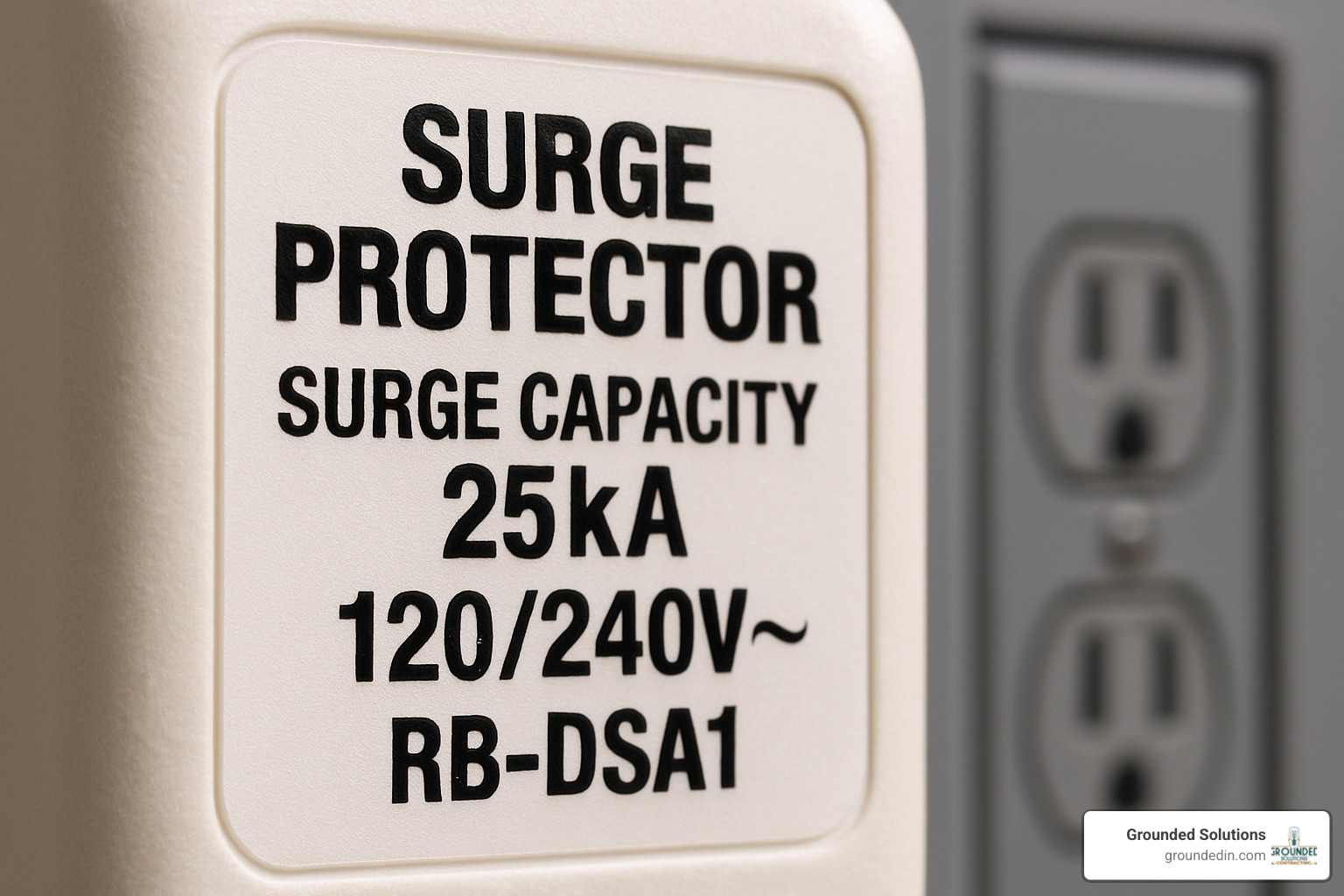
Reading the Specs Like a Pro
When you’re looking at surge protectors, you’ll encounter some technical jargon that’s actually pretty straightforward once decoded.
The surge capacity (or kA rating) tells you how much electrical current the device can handle during a surge event. Think of it as the width of your home’s electrical “safety valve.” Here in central Indiana, we typically recommend at least 25kA for basic protection, while 40-50kA works well for most homes. If you’re in a lightning-prone area like Zionsville or Carmel, or you have a house full of expensive electronics, consider stepping up to a premium 60-80kA system.
“I remember installing a system for a family in Carmel last summer,” shares our technical advisor. “Their home had been struck by lightning the previous year, and they lost thousands in electronics. We set them up with a 60kA system, and they’ve weathered every storm since without a hiccup.”
The energy dissipation rating (measured in joules) is like your protector’s lifetime energy “budget.” Once it’s used up, the device needs replacement. Quality whole-house units start around 40,000 joules. While higher is better, this spec matters more for those plug-in protectors than for your main panel unit.
Your protector’s clamping voltage is the threshold at which it springs into action – lower numbers mean faster protection. For safeguarding sensitive electronics, look for ratings under 400V. The response time (measured in nanoseconds) should be as quick as possible – top-tier protectors respond in less than a single nanosecond.
Modern units also come with handy indicator lights that show when protection is active or when replacement is needed. Some newer models even connect to smartphone apps so you can monitor your protection status from anywhere. These smart features provide peace of mind, especially during storm season.
Code & Compliance Check
The electrical world has evolved to recognize that surge protection isn’t just nice to have – it’s essential. The National Electrical Code (NEC) now requires surge protection for service replacements and upgrades in many states, including Indiana. Section 230.67 specifically mandates Type 1 or Type 2 SPDs for new and replacement services.
When shopping, look for the UL 1449 4th Edition certification. This isn’t just another acronym – it’s your assurance that the device has been rigorously tested for both safety and performance.
“Code compliance isn’t about jumping through hoops,” explains our master electrician. “These standards exist because they represent the best practices for keeping your home and family safe.”
Proper grounding is absolutely essential for your surge protection to work effectively. It’s like trying to drain water without a pipe – the excess electricity needs somewhere to go. Before installing any surge protection, our Grounded Solutions technicians always verify your home has proper grounding.
Want to learn more about keeping your electrical system in top shape? Check out our more info about electrical system maintenance guide.
When to Upgrade Your Panel or Add-On
Sometimes adding surge protection requires thinking beyond just the device itself. Most whole-house surge protectors need 2-4 spaces in your electrical panel. If yours is already packed full (which isn’t uncommon in older Indianapolis homes), you might need a panel upgrade or sub-panel installation.
Homes in established neighborhoods like Broad Ripple or Irvington often have older electrical panels that simply weren’t designed with modern surge protection in mind. In these cases, a panel upgrade isn’t just about surge protection – it’s an investment in your home’s overall electrical safety and capacity.
If you’re building a new home or already planning a panel upgrade, consider options with plug-on neutral designs that make surge protector installation cleaner and simpler. For larger homes or properties with detached structures like workshops or garages with their own electrical panels, you might benefit from protection at both the main panel and sub-panels.
“We recently helped a family in Fishers protect their home business equipment,” recalls our project coordinator. “Their home office was in a converted garage with its own sub-panel. By installing protection at both panels, we created a safety net for all their work equipment. The peace of mind was worth every penny, especially since they’d already lost one computer to a power surge the previous year.”
By understanding these specifications and considerations, you can make an informed choice about the right home surge protection system for your specific needs – and sleep better knowing your electrical investments are safe from the next big storm.
Installation & Maintenance Essentials
Installing a home surge protection system isn’t something you should tackle on a Saturday afternoon with a YouTube tutorial. This job involves working directly with your home’s main electrical panel—where mistakes can lead to serious injury or worse.

How Whole-Home Devices Are Installed
When our Grounded Solutions technicians arrive at your Indianapolis home to install surge protection, we follow a methodical process that prioritizes both safety and effectiveness.
We always begin by shutting down power at the main breaker—and then double-checking with testing equipment that no electricity is flowing. Safety isn’t just a buzzword for us; it’s the foundation of everything we do.
The physical installation varies slightly depending on your specific electrical setup. We’ll typically mount the home surge protection system either inside your panel (if there’s adequate space) or on its exterior. Some newer models click right onto the bus bars like a circuit breaker, while others need to connect through a dedicated breaker of their own.
“The wiring part is where experience really matters,” explains our senior electrician Tom. “We use heavy-gauge wires that can handle intense surge currents, making proper connections to the hot, neutral, and ground terminals.”
That ground connection is particularly crucial—we carefully test it to ensure it meets or exceeds all code requirements. Without proper grounding, your surge protector becomes about as useful as an umbrella with holes.
Before we flip the power back on, we perform multiple safety checks and verify that all connections are secure. Once power is restored, we test the system to confirm it’s functioning correctly. We’ll walk you through what the indicator lights mean and what to do if you notice changes.
“Most folks are surprised when I tell them the whole installation only takes about 90 minutes for a standard home,” says our service manager. “That’s less time than most people spend watching a movie, but it provides protection that lasts for years.”
Maintenance & Replacement
Unlike your water heater or HVAC system, surge protectors don’t just keep working indefinitely. They actually sacrifice themselves bit by bit to protect your equipment.
Check those lights monthly. Make it a habit to glance at your surge protector’s indicator lights when you’re near your electrical panel. Green typically means you’re protected, while red (or no light at all) suggests the unit may have taken hits and needs replacement. Think of it as checking the oil in your car—a small habit that prevents big problems.
After severe weather or power outages, it’s especially important to check your surge protector’s status. One of our clients in Carmel shared this experience: “After lightning hit a transformer near our neighborhood, I noticed our surge protector’s indicator had changed from green to red. Grounded Solutions replaced the unit the next day. Meanwhile, our neighbor without protection lost two TVs, their refrigerator control board, and their internet router.”
Most residential surge protectors last 5-10 years under normal conditions. However, if your home experiences frequent or severe electrical events, you might need replacement sooner. It’s similar to how brake pads wear down faster on a car that stops frequently in city driving.
Don’t forget about warranty considerations. Quality surge protectors often include connected equipment warranties that can reimburse you if your protected devices get damaged despite the surge protector. Keep your documentation and receipts for both the surge protector and your valuable electronics.
For Indianapolis homeowners, we recommend having your home surge protection system professionally inspected as part of your annual electrical maintenance. This ensures it remains ready to protect your home when lightning strikes or when that power surge comes rolling down the line from the utility company.
As one of our technicians likes to say, “Surge protectors are like insurance—you hope you never need them, but you’ll be incredibly grateful they’re there when you do.”
More info about electrical system maintenance
Frequently Asked Questions about Home Surge Protection
Do I still need plug-in strips after a whole-home protector?
Yes, for optimal protection, we recommend a layered approach. While a home surge protection system at your electrical panel provides excellent whole-house coverage, adding quality surge-protecting power strips for sensitive electronics creates an additional defense layer.
“Think of it like wearing both a seatbelt and having airbags in your car,” explains our customer service representative. “The whole-house protector is your seatbelt—your primary protection. The plug-in strips are like airbags—an extra layer of security for your most valuable items.”
This is particularly important for expensive electronics like high-end computers and gaming systems, home theater equipment, medical devices, and smart home hubs. When shopping for these secondary protectors, look for plug-in surge protectors with at least 2,000 joules rating and equipment protection warranties that offer real peace of mind.
How often do power surges occur in Indiana homes?
Indiana homeowners face several surge risk factors that might surprise you. Living in central Indiana means dealing with an average of 40-50 thunderstorm days yearly, with each storm potentially triggering multiple surges. If you’re in areas like Westfield, Noblesville, or Zionsville, you might experience even more due to the local terrain.
But it’s not just dramatic weather events you need to worry about. The average home experiences up to 100 small internal surges monthly just from appliances cycling on and off. These mini-surges often fly under the radar but cause cumulative damage over time—like tiny paper cuts to your electronics’ lifespan.
“During summer storm season, we typically see a spike in service calls related to surge damage,” notes our scheduling coordinator. “Many of these could have been prevented with proper surge protection.”
Utility-related surges present another challenge, especially in growing communities like Fishers, Brownsburg, and Avon. Grid switching, transformer issues, and power restoration after outages can all send unwanted voltage spikes through your home’s electrical system. As these communities expand and utility infrastructure gets frequent updates, these surges become more common.
Can surge protection extend the life of smart appliances?
Absolutely. Modern appliances contain sophisticated electronic control boards that are particularly vulnerable to power surges. A home surge protection system can significantly extend their operational lifespan.
One of our Greenwood clients shared this telling experience: “Before installing whole-house surge protection, we had to replace the control board on our refrigerator twice in three years at $300 each time. Since Grounded Solutions installed our surge protector, we haven’t had a single issue in over four years.”
Today’s smart appliances represent a substantial investment in your home’s comfort and efficiency. Your refrigerator with digital controls, smart washing machine, HVAC system with programmable thermostat, and home automation devices all contain delicate circuit boards that can be damaged by even minor power fluctuations.
What many homeowners don’t realize is that several appliance manufacturers now recommend or even require surge protection to maintain warranty coverage. This isn’t just a selling tactic—it reflects the growing understanding among manufacturers that power quality directly impacts appliance longevity.
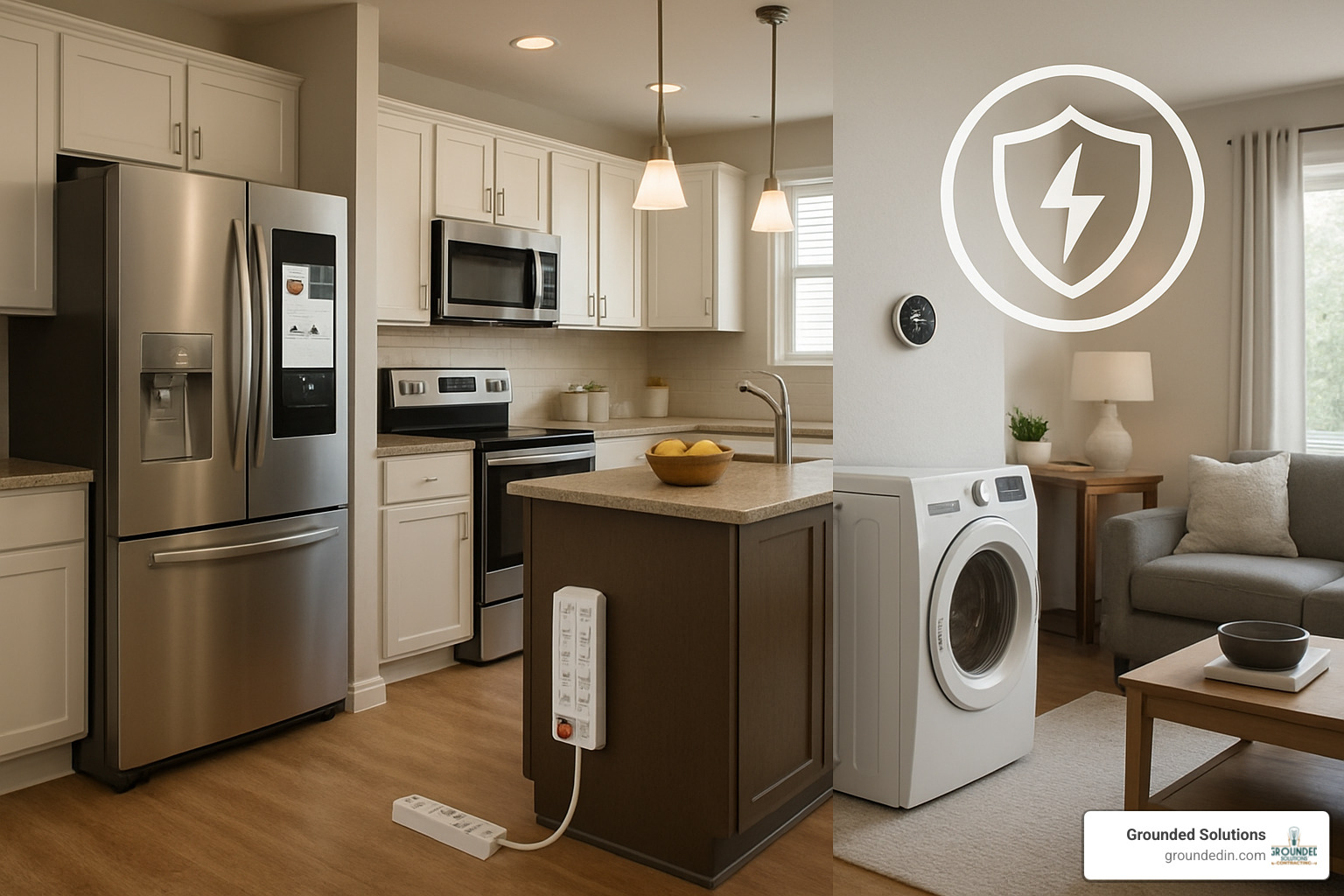
When you consider that replacing a single smart appliance control board can cost hundreds of dollars—not to mention the inconvenience—investing in a home surge protection system becomes one of the most practical decisions you can make for your Indianapolis area home.
Conclusion
In today’s increasingly connected homes, a home surge protection system isn’t just a nice addition—it’s become an essential safeguard for your family’s valuable electronics, appliances, and ultimately, your peace of mind. Throughout central Indiana, homeowners face a constant barrage of power surges, from the dramatic lightning strikes during our summer thunderstorms to the subtle, daily fluctuations caused by your own appliances cycling on and off.
Investing in quality surge protection delivers real, tangible benefits that most of our clients notice right away:
“After we installed whole-house protection for a family in Fishers, they called six months later just to thank us,” shares our lead technician. “They’d watched as neighbors replaced TVs and refrigerator boards after a particularly nasty storm, while their electronics remained perfectly protected.”
The return on investment comes in multiple forms—extended lifespan for your expensive electronics and appliances, prevention of frustrating data loss, potential savings on homeowners insurance premiums (check with your provider), and protection for those irreplaceable digital treasures like family photos and important documents that simply can’t be replaced at any price.
At Grounded Solutions, we’ve witnessed the difference proper surge protection makes for homeowners throughout Indianapolis and surrounding communities. From preventing catastrophic damage during severe weather to quietly safeguarding against those invisible daily micro-surges that slowly degrade electronics over time, these systems work tirelessly in the background to protect everything connected to your home’s electrical system.
The electrical landscape is changing rapidly. The 2020 and 2023 updates to the National Electrical Code reflect this new reality, with surge protection now required for many new installations and service upgrades. This isn’t just bureaucratic red tape—it’s recognition that our homes have fundamentally transformed into technology hubs requiring proper protection.
Whether you’re building a new smart home in Zionsville, renovating a charming bungalow in Broad Ripple, or simply wanting to protect your family’s electronics in Avon or Plainfield, our expert electricians at Grounded Solutions can help you design and implement the right home surge protection system custom to your specific needs and concerns.
I always tell my clients: Don’t wait until after a damaging surge to think about protection. By then, you’re already facing expensive repairs or replacements. Taking proactive steps today can save you significant headaches tomorrow.
Contact our team to schedule a professional assessment of your home’s surge protection needs and take the first step toward complete electrical peace of mind. Your home’s electronic ecosystem deserves nothing less than comprehensive protection.
More info about complete electrical service

